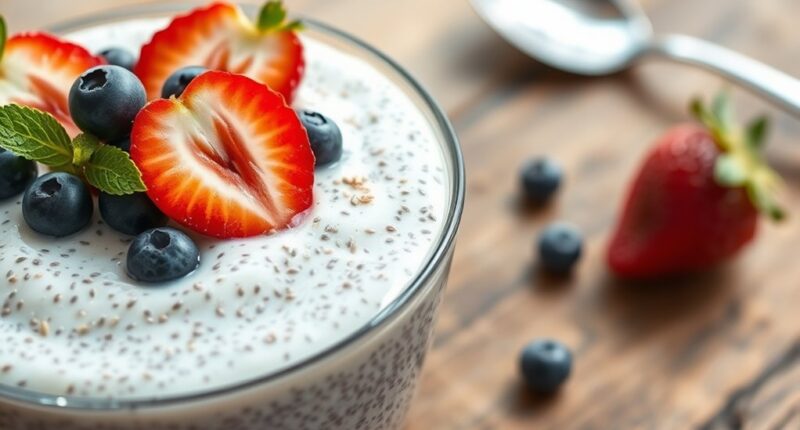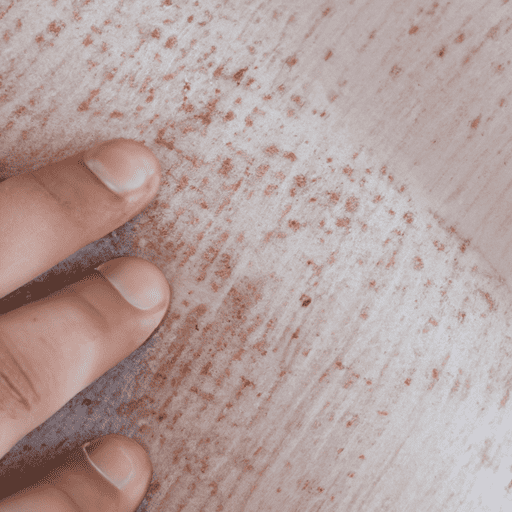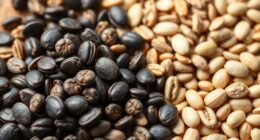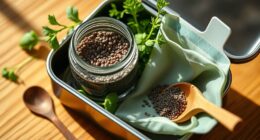To incorporate chia seeds into your high-fiber diet without bloating, start by soaking them in water, almond milk, or juice for at least 15 minutes to soften and create a gel. Introduce small amounts gradually and increase intake over time, pairing them with other fiber-rich foods. Stay hydrated and monitor your body’s response to prevent discomfort. Keep exploring these tips to enjoy the health benefits without belly troubles and discover more effective strategies.
Key Takeaways
- Soak chia seeds in water, almond milk, or juice for at least 15 minutes to soften and reduce bloating risk.
- Start with small amounts of chia seeds, like teaspoons, and gradually increase to allow your digestive system to adjust.
- Combine chia seeds with other high-fiber foods like whole grains and vegetables for balanced digestion and minimized discomfort.
- Drink plenty of water throughout the day to help fiber move smoothly through your digestive system.
- Incorporate diverse fiber sources slowly and pay attention to your body’s response to prevent bloating.
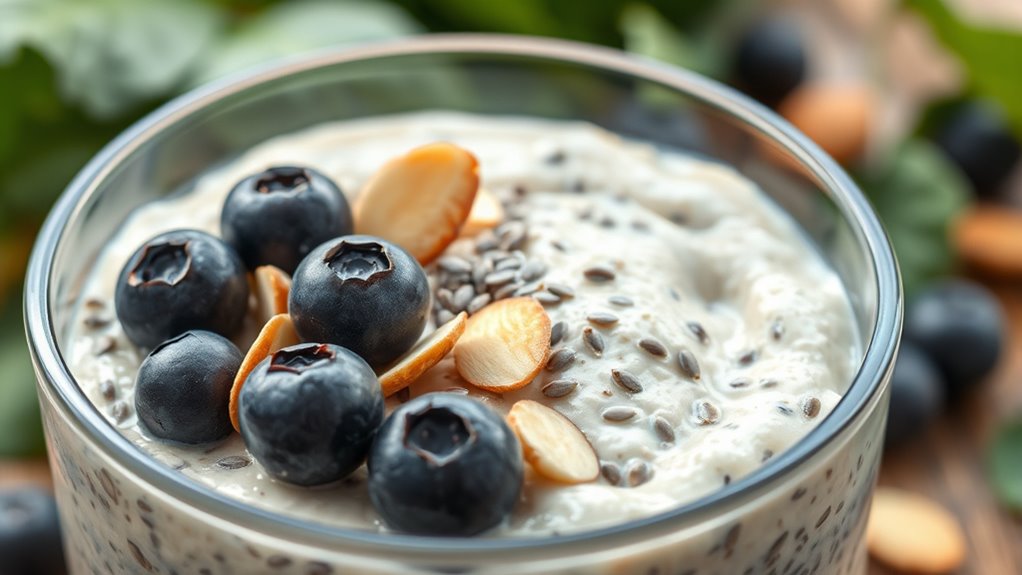
A high-fiber diet offers numerous health benefits, making it an essential part of a balanced lifestyle. When you’re focusing on increasing your dietary fiber sources, incorporating chia seeds can be a game-changer. Chia seed preparation is straightforward, and understanding how to prepare them properly can help you maximize their benefits without experiencing bloating. To start, soak chia seeds in water or your favorite liquid—such as almond milk or juice—for at least 15 minutes before consuming. This soak softens the seeds, creates a gel-like consistency, and makes them easier to digest, reducing the likelihood of bloating or stomach discomfort. You can also add them directly to smoothies, yogurt, or oatmeal, allowing them to absorb liquid naturally and soften over time.
As a versatile dietary fiber source, chia seeds pack a punch in fiber content—about 5 grams per tablespoon—making them an efficient way to boost your fiber intake. Incorporating chia into your meals ensures you’re getting a healthy dose of soluble fiber, which aids digestion and helps regulate blood sugar levels. To prevent bloating, start with small quantities, such as a teaspoon or tablespoon daily, and gradually increase as your body adapts. This slow introduction allows your digestive system to adjust, avoiding sudden increases that can cause discomfort. Remember, combining chia seeds with other fiber-rich foods, like fruits, vegetables, whole grains, and legumes, enhances your overall fiber intake and promotes better gut health.
Including proper preparation methods can further enhance digestibility and reduce bloating risks. In addition to chia seeds, diversify your dietary fiber sources to maintain a healthy, balanced diet. Whole grains like oats, brown rice, and whole wheat bread, along with fresh vegetables, legumes, nuts, and fruits, provide a broad spectrum of fiber types that work synergistically to support digestion. When adding these foods, pay attention to your body’s response. If you notice bloating or gas, consider reducing portion sizes or spreading out fiber-rich meals throughout the day. Drinking plenty of water is also vital, as fiber works best when it absorbs water, helping to soften stool and prevent constipation. By combining chia seed preparation techniques with a variety of dietary fiber sources, you can enjoy the benefits of a high-fiber diet while minimizing uncomfortable side effects. With consistency and mindful choices, you’ll find it easier to meet your fiber goals and enjoy improved digestion, sustained energy, and overall wellness.
Frequently Asked Questions
Can Chia Seeds Be Eaten Raw or Should They Be Soaked First?
You can eat chia seeds raw or soaked, but chia seed preparation often depends on your digestion. Raw chia benefits include convenience and nutrient retention, but soaking helps reduce the risk of bloating and improves digestibility. So, if you’re new to chia seeds or sensitive to fiber, soaking them for about 15 minutes or overnight is recommended. This way, you enjoy the benefits without discomfort, making your chia seed experience more enjoyable.
Are There Any Age Restrictions for Consuming Chia Seeds?
Think of chia seeds as tiny ships steering your body’s waters. Generally, there are no strict age restrictions, but children’s safety should be prioritized. Kids can enjoy chia seeds in moderation, but it’s best to introduce them gradually and make sure they’re soaked to prevent choking. Always consult a healthcare professional if you’re unsure, especially for young children or if they have health issues.
How Much Chia Seeds Is Recommended Daily for Fiber Intake?
Your fiber requirements vary, but generally, aiming for about 25-30 grams daily helps maintain healthy digestion. To meet this, your daily chia intake should be around 1 to 2 tablespoons, which provides roughly 5 grams of fiber. Start with a smaller amount to see how your body reacts, and gradually increase to avoid bloating. Incorporating chia seeds consistently helps you reach your fiber goals naturally.
Do Chia Seeds Interfere With Certain Medications?
Imagine you’re a modern-day alchemist, but beware—chia seeds can interact with certain medications. They may cause medication interactions by affecting how your body absorbs nutrients. You should talk to your healthcare provider before adding chia seeds to your diet if you’re on medication, especially blood thinners or blood sugar meds. Being cautious helps guarantee your nutrient absorption stays optimized without unintended side effects.
Can Chia Seeds Cause Allergic Reactions?
You might wonder if chia seeds can cause allergic reactions. While rare, chia seed allergies are possible and may lead to symptoms like itching, swelling, or difficulty breathing. Be aware of cross reactivity risks, especially if you’re allergic to other seeds or nuts. If you notice any adverse reactions after consuming chia seeds, stop eating them and consult a healthcare professional to guarantee safety.
Conclusion
By gradually adding chia seeds to your high-fiber diet, you can enjoy their health benefits without bloating. For example, imagine Sarah, who started with a teaspoon daily and increased gradually; she experienced improved digestion and felt more energetic. Incorporating chia seeds mindfully helps your body adapt, making high-fiber eating sustainable. So, take it slow, listen to your body, and enjoy the benefits of chia seeds as part of your balanced diet.
